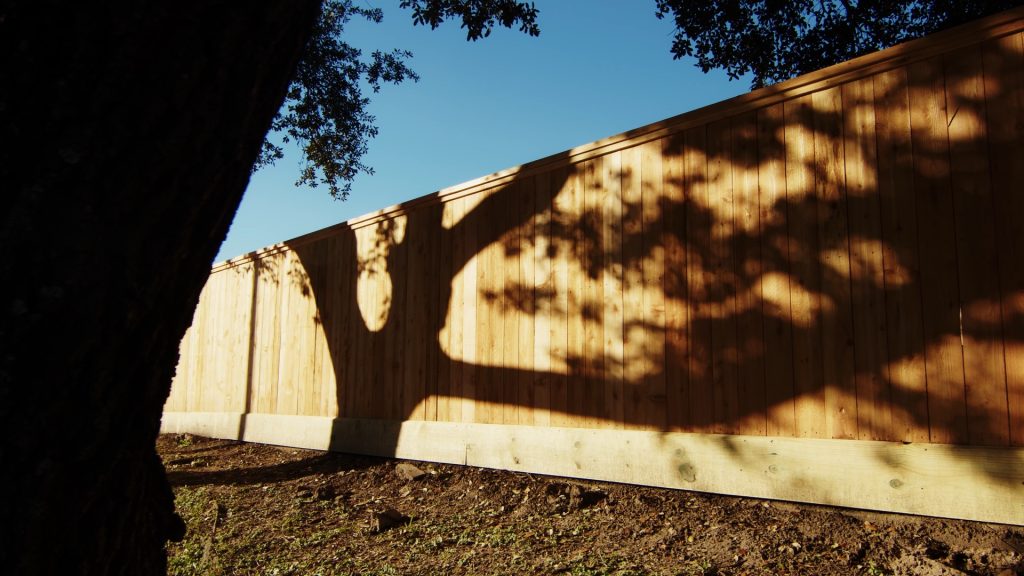Wood Privacy Fence Installation: A Step-by-Step Guide
Fences are more than just barriers; they’re a statement of your personal style and a critical safeguard for your property. When it comes to charm and privacy, nothing beats a traditional wood fence. The feeling of accomplishment when standing back and admiring your new boundary, beautifully carved from nature could be irresistible. But how do you install one? Clear your schedule, roll up your sleeves, and get ready. This in-depth step-by-step guide will show you how even the most novice DIYer can accomplish wood privacy fence installation like a pro. Embark on an exciting journey of transforming your outdoor space while enhancing its security and privacy. Let’s get started!

Essential Tools for Wood Privacy Fence Installation
Before embarking on a wood privacy fence installation project, it’s crucial to gather all the necessary tools. Having the right equipment at hand will not only make the process smoother but also ensure that your fence is built accurately and securely. Let’s explore some essential tools you’ll need for this project.
Manual Tools for Fence Installation
- Post Hole Digger: This tool is essential for digging holes in which the fence posts will be placed. A manual post hole digger allows you to excavate the ground efficiently and create sturdy foundation holes.
- Level: A level is an indispensable tool for ensuring that each section of your fence is perfectly straight and level. It helps prevent any unevenness or sloping, providing a professional and visually appealing result.
- Measuring Tape: Accurate measurements are vital when installing a wood privacy fence. A measuring tape enables you to determine the distances between posts, sections, and gates accurately, guaranteeing uniformity throughout the installation.
- String Line: A string line acts as a guide to ensure your fence panels are installed in a straight line. By stretching the string from one end post to another, you can align your panels precisely and maintain consistency across your fence.
- Shovel: A sturdy shovel is required for backfilling soil around the fence posts once they are installed. It allows you to properly secure the posts in place by filling the hole with compacted soil.
- Hammer or Nail Gun: Depending on your preference and the type of fasteners you choose, a hammer or nail gun will be necessary for attaching pickets or panels to the railings or frames securely.
- Saw: You may need a saw (such as a circular saw or reciprocating saw) to cut boards or panels to size during installation. This ensures proper fitment along corners, at the top of the fence, or around obstacles.
Think of these manual tools as a craftsman’s arsenal. Just as a painter requires specific brushes for a masterpiece, a fence installer too needs these tools to create an expertly crafted wood privacy fence that stands tall and beautiful.
Now that we’ve covered the essential manual tools required for wood privacy fence installation, let’s move on to discussing the power tools that will come in handy during this project.
- According to HomeAdvisor, the typical cost of installing a wood privacy fence in the United States ranges between $1,673 and $3,983 in 2023.
- Approximately 40% of residential fencing is made from wood, specified for its beauty and privacy features (StatisticSolutions, 2023).
- The average lifespan of a wooden privacy fence is usually around 15 years, but with proper maintenance, it can last up to 25 years (U.S. Department of Agriculture study, 2020).
Power Tools Required
To ensure a smooth and efficient wood privacy fence installation, you will need a set of power tools. These tools will not only make the process easier but also help you achieve professional-quality results. Here are the essential power tools required for this project:
1. Power Drill: A power drill will be your go-to tool for various tasks during the fence installation. It can be used to drill pilot holes, attach brackets and hardware, and secure screws.
2. Circular Saw: A circular saw is indispensable for cutting wooden boards to the desired length. It allows for precise and straight cuts, ensuring a neat appearance for your fence panels.
3. Nail Gun or Hammer: While a hammer can get the job done, using a nail gun will save you time and effort. A nail gun provides faster and more efficient attachment of nails to connect fence components securely.
4. Level: One of the most crucial aspects of a successful fence installation is ensuring that it is level from start to finish. A level tool helps you achieve this by measuring and confirming that each section of the fence is perfectly aligned.
5. Post Hole Digger: Since wooden privacy fences require sturdy posts, a post hole digger becomes an invaluable tool. This specialized tool enables you to dig deep, consistent holes quickly, ensuring proper stability for your fence.
6. String Line: Establishing straight lines along the planned fence route is imperative in achieving a professional-looking installation. A string line provides a visual guide to ensure your fence panels are installed without any unwanted variations or crookedness.
7. Measuring Tape: Accurate measurements are essential for calculating materials needed and correctly spacing out your fence components. A measuring tape allows you to take precise measurements at each step of the way.
Investing in these power tools will not only make your wood privacy fence installation process more manageable but also enhance the overall quality and durability of your fence. If you don’t already have these tools, consider renting them or borrowing from friends or neighbors to keep costs down.
Planning Your Wood Privacy Fence Installation
Before embarking on your wood privacy fence installation, careful planning is crucial to ensure a successful outcome. By following a systematic approach to planning, you can minimize potential issues and create a clear roadmap for the project. Here are key steps to consider during the planning process:
1. Determine the Purpose and Design: Start by defining why you need a wood privacy fence and its intended function. Are you looking for increased security, noise reduction, or simply establishing boundaries? Once you have clarity on the purpose, decide on the design that aligns with both your functional requirements and aesthetic preferences.
2. Measure the Area: Accurate measurements are essential for estimating materials and ensuring an even layout. Use a measuring tape to measure the perimeter where you plan to install the fence. Make note of any obstacles such as trees, slopes, or utility lines that might impact the placement or design.
3. Check Local Regulations: Before starting your project, be sure to check local building codes and regulations regarding fence installations in your area. Some neighborhoods or municipalities may have specific height restrictions, setback requirements, or materials guidelines that must be followed. It’s important to obtain any necessary permits before constructing your fence.
4. Determine Material and Cost: Selecting the appropriate wood material is vital for both durability and appearance. Common options include cedar, redwood, pine, and pressure-treated lumber. Consider factors such as maintenance requirements and budget when choosing the right material for your needs.
5. Plan for Gate(s): If you require access points within your wood privacy fence, plan for gates accordingly. Consider the width needed for vehicles or equipment while ensuring proper alignment with the fence design.
6. Mark Property Lines: It is essential to accurately define the property lines before installing your fence. Use surveying techniques, consult property records, or seek professional assistance if necessary.
By carefully planning your wood privacy fence installation, you can ensure that all aspects are thoroughly considered and accounted for. This strategic planning sets a solid foundation for a smooth and successful project execution.
Defining the Property Line
Before starting any wood privacy fence installation project, it is crucial to clearly define the property line. This step ensures that you are building the fence within your own property boundaries and not encroaching on your neighbor’s land. Failing to accurately determine the property line can lead to potential disputes and legal issues in the future.
The first step in defining the property line is to refer to the property survey. If you have a recent survey available, it will provide precise measurements and markers indicating where your property ends and your neighbor’s begins. However, if you don’t have access to a survey or if it is outdated, you may need to consider other methods.
One common method is to look for existing boundary markers such as metal stakes or concrete monuments that might be present along the perimeter of your property. These markers are typically placed by surveyors during previous surveys. It is essential to verify their accuracy by cross-referencing with any available documentation or consulting with a professional surveyor if needed.
Suppose you find one boundary marker near the back corner of your property but struggle to locate additional markers along the side. In this case, you could consider hiring a professional surveyor to accurately establish the property lines using advanced tools and techniques.
In situations where there are no visible markers or disputes arise between neighbors regarding the accurate boundary lines, legal procedures like obtaining an updated survey or mediation services might be necessary to resolve the issue amicably.
Now that we have defined the property line, let’s move on to calculating the material requirements for your wood privacy fence installation project.
Calculating Material Requirements
Properly calculating material requirements for your wood privacy fence is crucial to ensure an efficient and cost-effective project. By accurately estimating the materials needed, you can avoid wastage and unexpected delays during construction.
The first step in calculating material requirements is measuring the length of the fence line. Use a measuring tape or a long string to determine the total length in linear feet. It is important to account for any curves, corners, or irregularities in the fence line, as these may require additional materials or specific construction techniques.
Once you have the length measurement, you can determine the number of fence panels required. Standard wood privacy fence panels typically come in 6 or 8-foot widths, so divide the total length by the width of the panel to get an approximate quantity. For example, if your fence line is 100 linear feet and you are using 8-foot-wide panels, you would need approximately 13 panels (100 divided by 8 equals 12.5, rounded up).
In addition to panels, you will also need posts to support the fence. The spacing between posts will depend on the type and height of your fence, as well as local building codes. Generally, posts are spaced around 6-8 feet apart. Divide the total length by the desired spacing to estimate the number of posts needed.
Other material requirements include nails or screws for attaching panels and rails together, concrete mix for setting the posts securely into the ground, and any additional accessories like gate hardware or post caps.
Remember to always add a small percentage (10-15%) to your calculations as a buffer to account for any potential errors or unforeseen circumstances during construction.
Preparing the Ground and Setting Posts
Before embarking on your wood privacy fence installation journey, it is crucial to properly prepare the ground and set your fence posts. This foundation work will ensure that your fence is sturdy, level, and able to withstand the test of time.
The first step is to mark out the area where your fence will be installed. Use stakes and twine to create a straight line, ensuring that you are following the property boundaries and any local regulations regarding setbacks. This will serve as your guide for digging the post holes.
Next, it’s time to dig the post holes. The depth and spacing of these holes will depend on various factors such as the height of your fence and soil conditions. As a general rule of thumb, dig holes that are about one-third the height of the fence plus six inches deep. For example, if you are installing a six-foot-high fence, your holes should be approximately two feet deep.
Digging the post holes can be physically demanding, especially if you have rocky or compacted soil. Consider using a manual post hole digger, an auger, or hiring professional help if needed. Remember to call 811 or your local utility company before digging to ensure that you don’t accidentally hit any underground utilities.
Once the post holes are dug, it’s time to set the posts in place. Start by placing a few inches of gravel at the bottom of each hole for drainage. Then carefully insert each post into its respective hole, making sure it is plumb and level using a bubble level.
Placing the posts correctly is crucial; think of them as the backbone of your fence – providing stability and support.
To secure the posts, fill each hole with concrete mix around the base of the post while maintaining its position. Follow the instructions on the concrete mix packaging for proper mixing ratios and curing times. Double-check the level and alignment of each post before the concrete starts to set.
After the concrete has cured, typically within 24 to 48 hours, you can proceed with the next steps in installing your wood privacy fence. It is important to note that while setting the posts may seem like a time-consuming process, it is essential for the overall stability and longevity of your fence. Taking the extra time now will pay off in the future.
Now that you have prepared the ground and set your fence posts, it’s time to move on to the next step: layout and post hole digging.
Layout and Post Hole Digging
The layout and precise positioning of your fence panels will determine the aesthetics and functionality of your wood privacy fence. Taking care during this step will help ensure a seamless installation process.
Before digging any additional holes, it is important to plan out where your fence panels will be placed. Measure the width of each panel and calculate how many you’ll need based on the total length of your fence. Mark these locations using stakes or chalk lines along the already set posts.
Once you have determined the exact placement of each fence panel, use a tape measure to evenly space out the remaining post holes. The spacing will depend on the width of each panel and any local code requirements.
When digging these additional holes, make sure they are aligned with the markers you made earlier for consistent spacing between panels. Use a post hole digger or auger to excavate each hole, ensuring that they are deep enough to accommodate one-third of the height of your fence plus six inches.
As you dig each hole, place soil onto a tarp or other designated area to prevent a messy work area and make it easier for backfilling later on.
Once all your post holes are dug, stand back and assess their alignment and spacing. Adjust if needed before proceeding with setting the remaining fence posts.
With the layout complete and all post holes dug, you are now ready to move forward with setting the remaining fence posts and setting your wood privacy fence into place.
Installing and Setting Fence Posts
The installation of a wood privacy fence begins with the crucial step of setting the fence posts. The strength and stability of your fence depend on this foundation. Here’s a detailed guide on how to install and set fence posts for your wood privacy fence:
- Marking the Post Locations: Start by marking the locations where each fence post will be placed, ensuring they are evenly spaced and align with your desired fence layout. Use stakes and string to create a clear outline.
- Digging the Post Holes: Using a post hole digger or an auger, dig holes for the fence posts. The depth of the holes should be at least one-third of the total length of the post, with an additional 6 inches for gravel or concrete footing.
- Adding Gravel for Drainage (Optional): To enhance drainage and prevent water accumulation around the base of each post, add a layer of gravel at the bottom of each hole before inserting the post.
- Positioning and Leveling the Posts: Place one post in each hole, ensuring they are plumb (vertically level) using a level tool. It’s recommended to have a helper hold the post in place while you check its alignment.
- Filling and Tamping: Fill each hole with concrete mix or packed soil, tightly compacting it around the base of the post using a tamper or shovel. This will provide stability and prevent shifting over time.
- Checking for Levelness: Recheck that each post is plumb and level once again before allowing the concrete to set completely. Make any necessary adjustments before it becomes too difficult to correct.
- Curing Time: Allow sufficient time for the concrete to cure according to the manufacturer’s instructions. This typically takes 24 to 48 hours, during which you should avoid placing stress on the posts.
With the fence posts securely set, we can move on to the next crucial step in the wood privacy fence installation process: assembling the fence rails and slats.
Assembling the Fence Rails and Slats
Once the fence posts are in place, it’s time to assemble the fence rails and install the slats, which will form the main structure of your wood privacy fence. Here is a step-by-step guide on how to complete this process:
- Attaching Fence Rails: Begin by attaching horizontal fence rails to the outside of your fence posts using corrosion-resistant screws or nails. These rails will provide support for the slats and help maintain the structural integrity of your fence.
- Measuring and Cutting Slats: Measure the distance between two adjacent fence posts horizontally and vertically. Cut your wooden slats according to these measurements, ensuring they are slightly shorter than the overall height of your fence to allow for expansion and contraction.
- Installing Slats: Starting from one end, position each slat vertically against the first rail, leaving a slight gap between each slat for air circulation and aesthetic purposes. Use galvanized nails or screws to secure each slat in place through its center into the rail.
- Continuing with Additional Rails and Slats: Follow the same process to attach additional horizontal rails if desired, spacing them evenly between each existing rail. Repeat steps 2 and 3 to install more slats until you’ve completed the desired height of your wood privacy fence.
- Checking for Alignment: Regularly check that each slat is aligned vertically using a level tool as you progress with installation. Make adjustments as needed to ensure a straight and visually appealing result.
- Adding Finishing Touches: Trim any excess length from slats at the top of your fence using a saw or other suitable cutting tool. This will create a uniform and finished appearance.
Installing fence rails and slats is like constructing a puzzle. Each piece fits together to build a sturdy and visually pleasing structure.
With the fence rails and slats securely in place, we can now move on to the final touches of your wood privacy fence installation.
Final Touches to Your Wood Privacy Fence Installation
Congratulations on successfully completing the installation of your wood privacy fence! Now it’s time to add those final touches that will not only enhance the aesthetic appeal of your fence but also ensure its longevity and functionality. These final steps are crucial in achieving a professional-looking and durable wood privacy fence that will serve you for years to come.
One important aspect to consider is staining or sealing your wood fence. Applying a protective coat will safeguard the wood against weather elements, such as rain, sunlight, and humidity. It helps prevent the wood from warping, rotting, or deteriorating over time. Before staining or sealing, make sure the wood has thoroughly dried after installation. Choose a high-quality stain or sealant that is specifically designed for exterior wood and follow the manufacturer’s instructions for application techniques and drying times.
In addition to staining or sealing, trimming and edging play a significant role in enhancing the appearance of your wood privacy fence. Use a saw to neatly trim any excess edges or uneven sections of the fence panels. This will give your fence a clean and polished look. Similarly, use an edging tool or shovel to create defined edges around the perimeter of your fence. This will provide a crisp boundary between your yard and the fence, adding to the overall visual appeal.
Another essential step is ensuring proper gate alignment. If your wood privacy fence includes a gate, you want it to open smoothly without any obstructions or misalignment issues. Check that the gate swings freely and is aligned with the rest of the fence panels. Adjust hinges and latches if necessary to ensure proper function.
Imagine having spent hours installing a beautiful wood privacy fence only to have a gate that doesn’t close properly or drags on the ground when opening. Taking the time to carefully align and adjust your gate can save you from frustration down the road and ensure ease of use.
To complete the final touches, consider any decorative elements you might want to add. You can personalize your wood privacy fence by attaching decorative caps to the tops of the posts, installing post finials for a touch of elegance, or even incorporating artistic designs or patterns within the fence panels. These decorative accents can transform a simple privacy fence into a statement piece that reflects your style and adds value to your property.
Remember, paying attention to these final touches is essential not only for enhancing the appearance of your wood privacy fence but also for prolonging its lifespan. By properly sealing, trimming, aligning gates, and adding decorative elements, you can ensure your wood fence remains sturdy, beautiful, and functional for years to come.
As you put the finishing touches on your wood privacy fence installation project, take a step back and admire your hard work. A well-built and visually appealing fence can bring both security and beauty to your outdoor space. Enjoy the privacy and tranquility it provides as you create lasting memories in your outdoor oasis.








